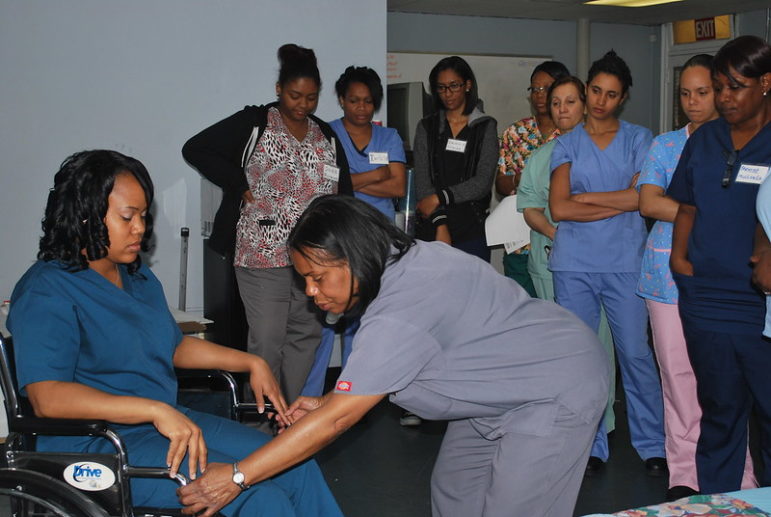
PHI
A 2015 training for home-care workers.New York State is changing. Our population is becoming older. The number of New Yorkers aged 65 and older is expected to increase by almost 1 million from 2016 to 2026, according to projections by Cornell University. Meanwhile, the number of New Yorkers aged 18 to 64 is projected to decrease by almost 400,000.
This shift has led to more New Yorkers depending upon the home-care services that enable them to live happier and healthier lives in their communities. Although we’ve long known that our demographic changes would lead to an increased need for workers, our federal and state governments have continued to invest as little as possible in the workers who provide this pivotal care – perpetuating low wages for home-care workers, limited benefits, and otherwise poor job quality.
As a result, unsurprisingly, we’re experiencing a workforce shortage that’s preventing New Yorkers from accessing home-care services. And the shortage is expected to grow. New York will need to fill almost 745,000 home-care jobs in the next decade—a challenge that the state is unprepared to meet.
We will never be able to recruit and retain enough workers if we don’t invest in these jobs. I would know. I used to work as a home health aide. After passing a two-week certification course that taught me the basics, I was told to call my supervisor only if there was a problem. The variety and importance of tasks I was required to perform – many of which my training didn’t prepare me for – was overwhelming. I struggled to transfer clients twice my size from their bed to a wheelchair without injuring my back. I learned what food was best to make for my client with diabetes. I took a break to control my emotions after being slapped by a client with advanced Alzheimer’s because I, a perceived stranger, was helping her in the bathroom. Day after day, I performed a myriad of tasks that improved the quality of care and quality of life for my clients while enabling their families to work or take a break from the never-ending demands of caregiving.
For this vital work, however, I was paid around minimum wage and had to use my own car to get to clients (without gas or mileage reimbursement). There were no clear career advancement opportunities available and I rarely felt valued or supported. It’s no wonder that annually 40 to 60 percent of the home-care workforce leaves, making the shortage much worse.
To be sure, addressing the workforce shortage requires an up-front investment. But, as New York tackles a challenging state budget season, we cannot afford to continue to ignore it. The direct costs of the shortage, such as increased hospitalizations and nursing home placements, as well as the indirect costs, such as lower economic productivity of workers and family caregivers, are too great.
 CityViews are readers’ opinions, not those of City Limits. Add your voice today!
CityViews are readers’ opinions, not those of City Limits. Add your voice today!
In my current role as the State Policy Manager at PHI, a national non-profit that seeks to improve the quality of long-term care by improving the quality of direct care jobs, I have worked with a variety of stakeholders to improve home-care worker recruitment and retention. Together we have arrived at four recommendations for addressing the workforce shortage that should be included in this year’s state budget:
Create a plan – The Governor should convene a home-care workforce shortage taskforce that identifies opportunities and removes barriers to improving worker recruitment and retention.
Identify effective strategies – The budget should include funding to create a Home Care Jobs Innovation Fund to test and assess innovative recruitment and retention strategies and determine which should be scaled up across the state.
Establish career advancement opportunities – To support career advancement for home-care workers, this year’s budget should include funding to pilot-test the new advanced home health aide occupation, which will not otherwise be implemented.
Track progress – To be able to better quantify the size of the shortage and gauge the impact of policy fixes, the budget should allocate funding for the Department of Health and Department of Labor to improve data collection on this workforce, including by auditing current data sources, establishing new data collection mechanisms, and issuing an annual report on this workforce.
If we include these four strategies in this year’s budget, New York will be on its way to enabling its home-care system (and all the individuals and employers it supports) to go the distance.
Allison Cook is the New York Policy Manager at PHI.









One thought on “Opinion: NY Must Invest in its Home-Care Workers”
What about 24 hour pay for 24 hour work……working eleven
hours without pay is like slavery…
…..